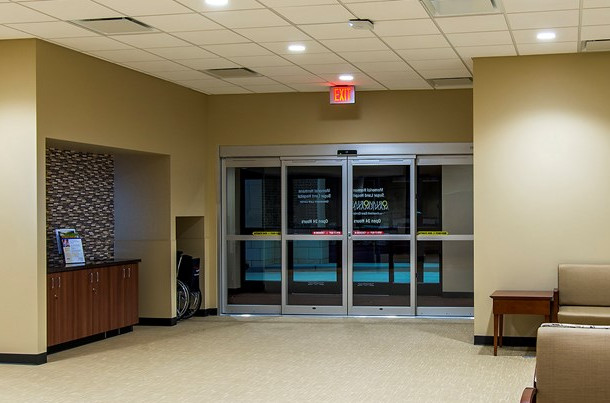
Whether it’s for convenience, compliance or cost savings, more and more facilities are upgrading with automatic door systems. This trend showcases the versatility of products and configurations available today, but so much variety also comes with the burden of choice.
If you’re still not sold on the value of automatic doors, consider the growing consumer preference for them in everything from shopping malls and commercial buildings, to airports and hotels. In fact, a survey by the America Association of Automatic Door Manufacturers (AAADM) found that nearly 60% of respondents expected their hotel to have automatic doors.
That survey was conducted more than 10 years ago. You can bet that number has only risen.
Key Considerations
If you’ve ever considered upgrading your building’s entrance with automatic doors, you might have wondered which option makes the most sense in your case, and where to start the research process.
Most automatic door systems can be grouped into two categories: swinging and sliding. This basic distinction covers everything from form and function, to how it will be installed and integrated with other systems. And although either kind of automatic door system could be suitable for your facility, it’s helpful to understand where they differ and what advantages they offer.
The Pros and Cons of Automatic Swing Doors
Opening with an outward or inward motion, automatic swing doors are a common sight at office towers, apartment and condo buildings, shopping centers and schools, among other facilities. You can usually recognize swing doors from afar by the presence of a push-plate switch nearby.

The Besam SW100 is one of the most intelligent swing door operators available on the market. Its near-silent operation is energy efficient and comes with battery-backup and monitoring for safe, reliable performance.
But some use infrared sensors to open without activation by an individual. The Pro-Swing Elite T by OPTEX is just one example. For added safety, the sensor will detect anyone in the door’s swing path and stop it from opening, even if it’s already in motion.
In some cases, the most efficient option could be a mix of manual and automatic functioning. Whereas sliding doors can only be opened automatically, swing doors offer the choice of manual opening and, when needed, opening via a handicap push-plate switch. This versatility can prolong the life of the automatic-operating components and reduce energy consumption (though low-energy operators can help with that too).
Here are a few more defining characteristics of automatic swinging doors:
- Ideal for one-way traffic (a dedicated door for each direction)
- Typically operated with push plate but can also use sensors
- Also available in low-energy models for more efficient operation
- Can handle heavy doors (up to 250 lbs in weight)
- Suitable for interior and exterior use
- Suitable for high-traffic entrances
- Available as a single door or pair of doors
- Allow for cost-efficient retrofitting of existing swing doors
- Most popular configurations are surface-mount and overhead concealed operators
The Pros and Cons of Automatic Sliding Doors
If there’s a clear advantage of sliding doors, it’s their use of sensor technology (notwithstanding exceptions to the rule for automatic swing doors, such as the Pro-Swing Elite mentioned above). Removing the need to activate the door operator makes access more convenient, and is especially helpful in hospitals and other applications where ease of use is critical (as a bonus, this minimizes the spread of germs).

Sliding doors are a common sight at hospital entrances, where convenient hands-free access is a high priority.
Aesthetically, sliding doors tend to create a sleeker, subtler appearance, particularly with the use of an overhead concealed sensor. And due to the lateral movement of automatic sliding doors, there’s no need to accommodate the swing path as with inward-swinging doors. This frees up more usable space between sets of doors for waiting pedestrians.
Here a few more common characteristics of automatic sliding doors:
- Ideal for two-way traffic using the same access point
- Sleeker design due to lateral opening function
- Typically open with the use of sensors
- Popular with hospitals
- Suitable for exterior and interior use
- Available in single-slide and bi-part slide packages
- Requires extensive work if converting a swing-door system to sliding
- Most popular configurations are surface-mount and overhead concealed operators
Ready to Take the Next Step?
Every application is unique and comes with its own set of considerations, so it’s a good idea to speak with a professional first. These considerations include direction and volume of traffic flow, compliance requirements (e.g. AODA, ANSI A156.10, etc.), wind load requirements, aesthetics, energy conservation, budget and whether it’s a retrofit or new construction project.
As AAADM certified and trained technicians, ABC Security supplies, installs and maintains automatic door systems from top brands such as Besam, Norton, Ditec and Camden Controls. To speak with a product specialist about a sliding or swinging door solution for your facility, call 416-614-7777 or contact ABC online.


 blog
blog